The definitions below are designed to help you understand climbing training, as such they gloss over a lot of details that aren’t so important in this context. This is particularly true for the biological processes described (energy systems, ATP-CP etc.)
1RM
One rep maximum. The maximum weight you can move for a single rep. e.g. “My 1RM deadlift is 100kg”.
2RM
Two rep maximum. The maximum weight you can move for 2 consecutive reps. e.g. “My 2RM weighted pull up is 50kg”.
Atrophy
A decrease in the volume of a muscle due to the degeneration of its component cells. Not what we want to achieve when training! See also Hypertrophy.
Aerobic Capacity
The maximum amount of energy that can be produced by the aerobic system. See also Energy Systems and Aerobic System.
Aerobic Power
The maximum rate at which energy can be produced by the aerobic system. Typically this is trained after a base phase and in the run up to a peak period. See also Energy Systems and Aerobic system.
Aerobic System
One of the three major energy systems. The aerobic system combines oxygen with glucose from the blood or glycogen from within the muscle cell and fatty acids as the main fuel to produce ATP. Unlike anaerobic glycolysis no lactic acid is produced. See also Energy Systems
Anabolic Process
An anabolic process is a metabolic process in the body that builds macromolecules from smaller chemical units, e.g. the production of protein from amino acids. It usually costs energy to complete. See also Catabolic Process.
Anaerobic Capacity
The maximum amount of energy that can be produced by anaerobic glycolysis. See also Energy Systems and Anaerobic Glycolysis.
Anaerobic Glycolysis
The transformation of glycogen to lactate when minimal quantities of oxygen are available. Typically this occurs during intense exercise ranging from 10-120 seconds. See also Energy Systems.
Anaerobic Power
The maximum rate at which energy can be produced via anaerobic glycolysis. Typically this is trained after a base phase and in the run up to a peak period. See also Energy Systems and Anaerobic Glycolysis.
Antagonist Training
Colloquially, antagonist training refers to the training of muscles that are generally under-used in climbing with the aim of minimising the risk of injury. See also Conditioning and Prehab.
Anterior Pelvic Tilt
Forward rotation of the hips/pelvis. See also Posterior Pelvic Tilt.
Ape Index
An anthropometric measurement that looks at the difference between height and arm span. Calculated as ape index = arm span – height and typically measured in inches e.g. I am 5ft8 and have a 5ft9 arm span, so my ape index is +1 inch.
Ape index typically ranges from around -3 inches to +3 inches, though more extreme cases are not uncommon.
ATP
Adenosine triphosphate. A chemical that provides energy within cells. ATP is the only source of energy for muscular contractions. It is stored in small amounts within muscles and when it is depleted the other energy systems re-synthesise it. See also Energy systems, Anaerobic Glycolysis and Aerobic system.
ATP-CP
Adenosine Triphosphate and Creatine Phosphate, the first of the 3 major energy systems. Also called the anaerobic alactic system. These chemicals are available within your muscles and are able to provide energy to the cells very rapidly. Typically stores of ATP and CP within the muscle can produce energy for 8-10 seconds before being depleted. See also Energy systems.
ARC
Aerobic, Respiration, and Capillarity training. Also called Specific Aerobic Capacity and Capillarity (SACC) training. Very low intensity and high volume exercise that aims to improve the capillarisation in your forearms.
Bachar Ladder
A training tool consisting of a rope ladder mounted diagonally between 2 points for the purpose of campusing between the rungs.
Basal Metabolic Rate
The amount of energy, measured in calories, required for the body to function at rest.
Beta
Information about a route or boulder problem. For example, information about the sequence of moves to use on a boulder problem, or where a good resting position is on a route.
BFR
Blood flow restriction. This is a technique whereby arterial blood flow is restricted (typically using a pressure cuff) during exercise. Most often used in a rehabilitation environment to elicit muscular fatigue at reduced training intensity and aid in hormonal response and adaptation.
Buffering
The lactate buffering system delays the onset of fatigue by decreasing the acidity of the blood which fuels the exercising muscles. An excess of H+ ions causes muscles to cramp and therefore failure and that feeling of ‘powering out’ occurs.
BW
Bodyweight.
Calorie
The amount of energy required to heat 1g of water to 1 degree celsius. Measured in Kcal.
Campus
A move or series of movements that are performed without using feet. Can also refer to moves, exercises or training on a campus board.
Campus Board
A systematic training tool based on evenly spaced rungs on a slightly overhanging wall. Typically used to train strength and power.
Originally developed by German climber Wolfgang Güllich.
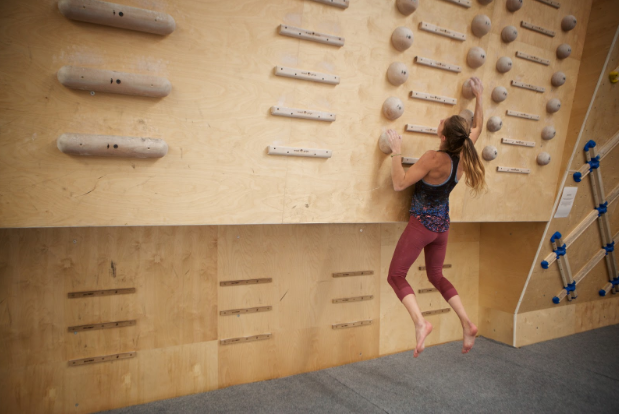
Capillarisation
The formation and development of a network of capillaries to a part of the body. Usually trained by aerobic exercise.
Catabolic Process
A catabolic process is a metabolic process in the body that breaks down complex molecules into smaller molecules , e.g. the breakdown of glycogen to glucose. It usually releases energy. See also Anabolic Process.
Center of Gravity
The center of gravity of an object is the point at which weight is evenly dispersed and all sides are in balance. A climbers center of gravity can change as they take on different positions. Being aware of ones center of gravity will aid in finding more stable positions on the wall and is an important part of good technique.
Central Fatigue
Fatigue associated with the central nervous system; the brain and spinal cord. Central Fatigue can be caused by prolonged or repeated exercise bouts and effects exercise performance and muscle function regardless of peripheral factors affecting muscle function. See also Muscular Fatigue.
Circuit Board
A circuit board is a training tool that allows a climber to do long (typically >20 move) sequences without having to use a rope.
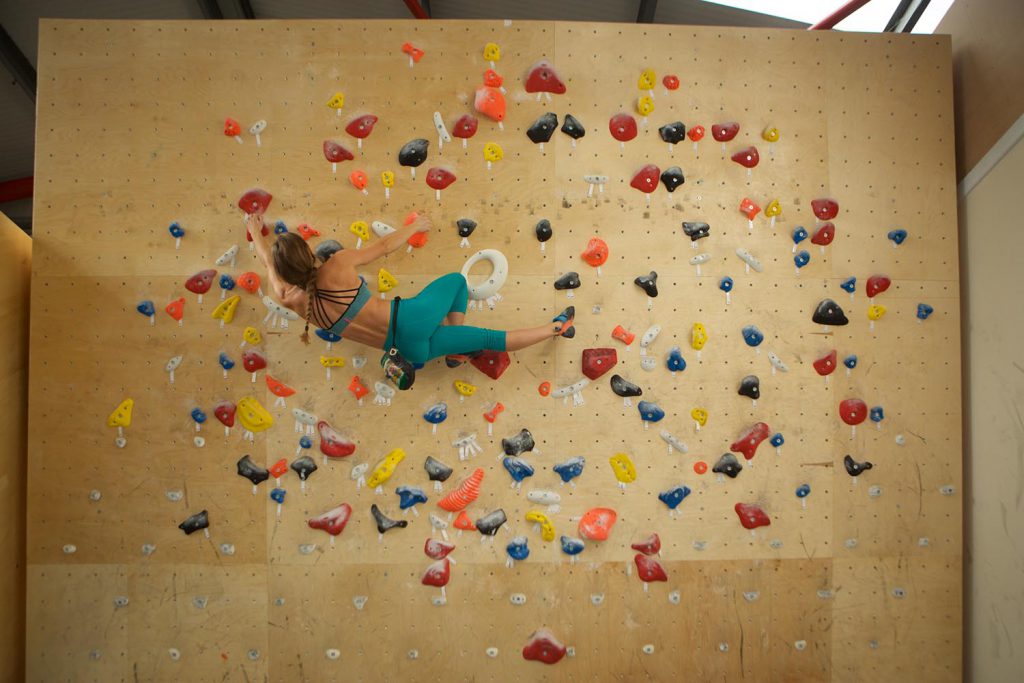
Climbing Age
The number of years someone has been climbing for. See also Training Age.
Concentric Contraction
A concentric contraction is a type of muscle activation that causes tension on your muscle as it shortens. See also Eccentric Contraction and Isometric Contraction.
Conditioning
The process of preparing your body for future, more intense workouts. Conditioning style workouts are typically high volume and low intensity.
Contact Strength
A climber’s ability to quickly apply their strength to a hold e.g. jumping and catching a small hold requires good contact strength. See also RFD.
Core Strength
The strength of the abdominal muscle group.
Core Tension
See Trunk Stability.
Critical Force
The maximum work that a muscle group can maintain for an extended duration without fatigue. Critical force is limited by the availability of oxidative substrates (glycogen), hyperthermia, and central fatigue. See also Critical force curve.
Critical Force Curve
For a given exercise, a plot of the intensity of that exercise vs. the duration for which it can be sustained.
Different measures can be computed from an athlete’s critical force curve, primarily the critical force itself and W’. In turn we can infer the behavior of the athlete’s energy systems from these measures.

Deadhang
An isometric fingerboard exercise where you hang statically from the fingerboard. In practice most fingerboard exercises are variations on this with specific work/rest times, intensities and grip positions chosen to target specific areas e.g. 40% of max intensity repeaters in a half crimp position.
Deadpoint
A dynamic movement with the aim of catching the target hold at the very top of the jump. If performed correctly this minimises the force required to hold on.
Deload
An extended period of training at reduced volume and intensity to enable improved recovery, usually prior to a peak period. E.g. “We’ve scheduled a 2 week deload period before your trip to Yosemite.”
Dorsiflexion
Flexing the ankle in the motion of bringing your toes towards your shin. Opposite of plantar flexion.
Eccentric Contraction
An eccentric contraction is a type of muscle activation that causes tension on your muscle as it lengthens. See also Concentric Contraction and Isometric Contraction.
Efficiency
See Movement Economy.
Endurance
Colloquially, the ability to exert yourself for an extended period of time. In a climbing context, typically refers to efforts of 5+ minutes. E.g. “That 40m sport pitch required a lot of endurance!”
Energy Balance
This is the relationship between energy intake and energy expenditure, measured in calories.
Energy Availability
This is the amount of energy left over, after exercise, that is available for the body’s basic functions.
Energy Expenditure
This is the energy released from the body which is made up of BMR, Non-Exercise Activity Thermogenisis, Exercise expenditure and the thermic effect of food (energy used in digestion).
Energy Intake
This is energy taken into the body as food. We can also store energy in the body in the form of glycogen and adipose (fat) tissue.
Energy Systems
Methods your body uses to convert chemical energy into mechanical energy. In a climbing context we are typically interested in 3 main pathways: ATP-CP, Anaerobic Glycolysis and the Aerobic System.

Energy Systems Training
The concept of applying training load to a specific energy system to improve the gains you see from that training relative to the work put in.
External Rotation (of the Femur/Hip)
Outward rotation of the femur/hip.
External Rotation (of the Shoulder)
Outward rotation of the upper arm (humerus).
External Rotators (of the Femur/Hip)
A group of deep muscles involved in the external rotation of the hip including; piriformis, superior and inferior gemelli, obturator internus, and quadratus femoris.
External Rotators (of the Shoulder)
The group of muscles involved in external rotation of the shoulder. Includes infraspinatus and teres minor.
Fingerboard
A tool for training finger strength. Typically consists of several types of hold mounted so that the climber can perform isometric hangs from them.
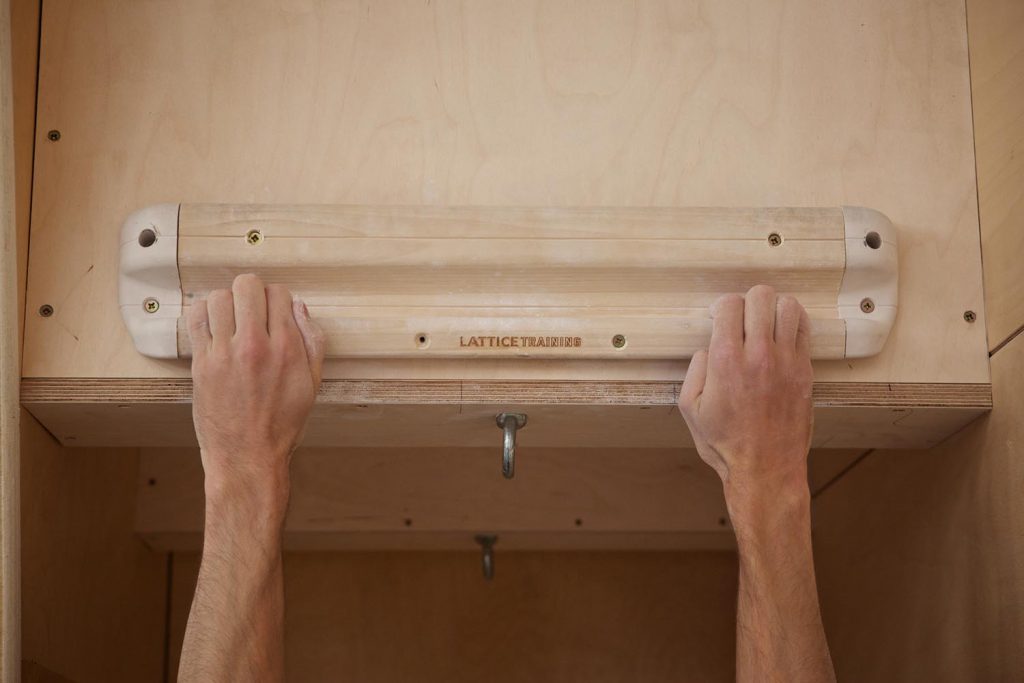
Finger Strength
Force exerted by the forearm flexor through the fingers. In the context of climbing training, this usually means the maximum force that can be exerted e.g. “My finger strength is 130%BW in a 2 handed hang”
Flash
To climb a route or boulder problem first try, having not practiced the moves. Information about the climb is allowed, for example beta from a friend or watching a video of the climb on youtube.
Flash Pump
Colloquially, flash pump is becoming extremely pumped when not properly warmed up. It can take substantially longer to recover from than a normal pump.
By not warming up properly, the climber has failed to prepare their body for maximal work and the hormonal changes that take place when warming up have not occurred. Hence, capillaries have not dilated and blood flow to the muscles is limited. This means that the muscles end up working very hard with a limited energy supply, as well as finding it even harder to deal with the byproducts of maximal work. They fatigue quickly and this fatigue tends to be harder to recover from due to the inappropriate environment the muscles were asked to work hard in.
Flexibility
The range of movement in a joint or series of joints, and length in muscles that cross the joints to induce a bending movement or motion. It is important to differentiate flexibility from mobility.
Full Crimp
Like a half crimp but with the use of a thumb wrapped over the index finger to allow extra force through the fingers. Should be used with caution as it produces a greater force on connective tissues within the fingers. See also Half Crimp and Open Grip.

Glycogen
A polymer made up of glucose molecules that is used to store carbohydrate in the body and can be broken down to provide glucose.
Half Crimp
A grip position where the index, middle and ring fingers should be at 90 degrees, with the pinky typically a little straighter. Everyone is anthropometrically different, hence in those climbers with a shorter index, they may struggle to get every finger to 90 degrees. The thumb should be off to the side or under the hand.
The half crimp is the most common grip position used for fingerboard training as it offers the least mechanical advantage and therefore the greatest training stimulus and potential strength gain.

Hangboarding
See Fingerboarding.
Hip Abduction
Moving the leg away from the mid-line of the body.
Hip Abductors
The muscles located on the outside of the hip that are involved in hip abduction. These include: gluteus medius, gluteus minimus, and tensor fasciae latae (TFL).
Hip Adduction
Moving the leg in towards the mid-line of the body.
Hip Adductors
The muscles located in the inner thigh that are involved in hip adduction. These include: gracilis, obturator externus, adductor brevis, adductor longus and adductor magnus.
Hip Flexion
Bringing the knee towards the chest. For example, a high step move would involve hip flexion.
Hip Flexors
Muscles involved in hip flexion including; iliacus and psoas muscles, also known as your iliopsoas, the rectus femoris and sartorius.
Hypertrophy
An increase in the volume of a muscle due to the enlargement of it’s component cells. For example, a common goal of a bodybuilding exercise is muscular hypertrophy. See also Atrophy.
Intensity
The intensity of a session or workout refers to the relative effort of the exercises involved. For example, Max Hangs should be performed close to a maximum effort and are therefore a high intensity session. Conversely a session focusing on technique will typically be low intensity to allow the climber to focus on their movement.
Internal Rotation (of the Shoulder)
Inward rotation of the upper arm (humerus).
Internal Rotators
The rotator cuff muscles involved in internal rotation included subscapularis and teres major. The pectoralis major and latissimus dorsi are also involved in internal rotation.
Isometric Contraction
During an isometric contraction the muscle neither shortens or lengthens yet it is still activated under a load. See also Eccentric Contraction and Concentric Contraction.
Kilter Board
A woody that also includes a lighting system and app to help in recording problems. See also Moon Board and Tension Board.
Knee Extension
Straightening of the leg i.e. moving from bent to straight leg when contracting your quadriceps.
Lactate
A byproduct of anaerobic production of ATP from glucose. Sometimes referred to as lactic acid, but exists as lactate under physiological pH.
Lattice Board
A Lattice Board is a systematic training tool that allows you to do long sequences of moves at a consistent level of difficulty. It also allows you to target specific techniques in a regimented fashion.
Because the difficulty of each move on a Lattice Board is consistent it is also a useful profiling tool.
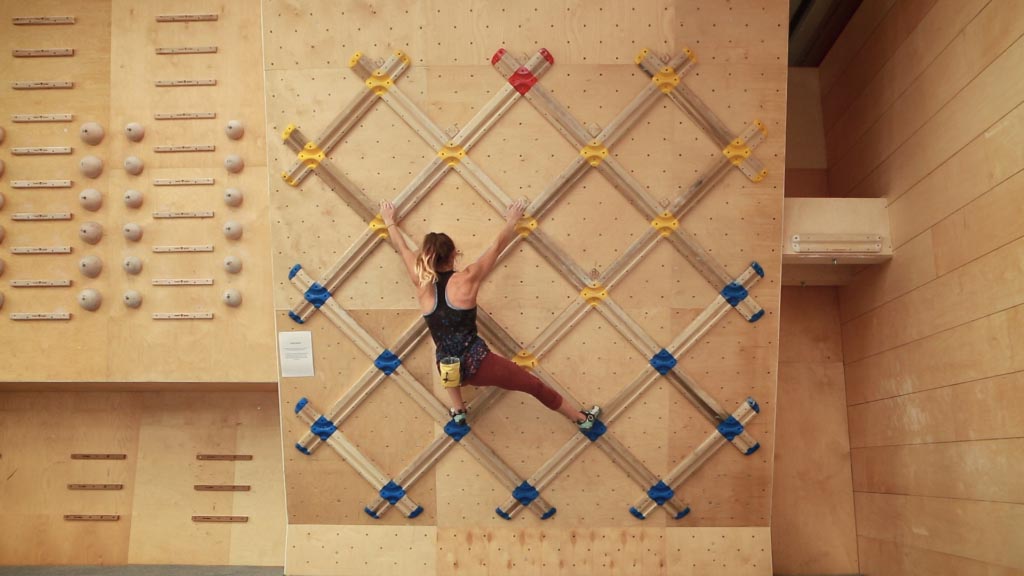
Limit Bouldering
The process of trying boulder problems that are at and above your current limit. This would typically involve working moves extensively with the aim of linking them together to finish the boulder problem.
Lock Off
An isometric pull up-style exercise where you stop mid-way through a pull up and hold the position for a period of time. Also performed on one arm.
Macros
See Macronutrients.
Macronutrients
Carbohydrate, protein and fat. The major nutrients required for a healthy diet. See also Micronutrients.
Max Hangs
A low volume fingerboard exercise that aims for short duration hangs (typically 5-10 seconds) at or close to your maximal load (90-100% of maximum intensity). Rest between reps is typically 2-5mins.
Mesocycle
A shorter cycle within a periodised training plan. Lattice typically uses 4 week mesocycles.
Metabolism
A number of chemical reactions taking place in the body used to sustain life, thus allowing organisms to grow and reproduce, maintain their structures, and respond to their environments.
Microcycle
A microcycle refers to the smallest unit within a periodised training plan; usually a week of training. See also Periodisation.
Micronutrients
Vitamins and minerals found in foods that are needed by the body for a variety of processes. See also Macronutrients.
Mobility
The active range of one’s flexibility. Given that climbing is an active activity, measuring mobility where possible is very important.
Moon Board
A woody that also includes a lighting system and app to help in recording problems. See also Kilter Board and Tension Board.
Movement Economy
An element of good technique related to how efficiently a climber moves. Specifically, the energy expended to perform a given sequence of moves relative to an optimal sequence. For example, pausing in the middle of a crux sequence would show poor economy of movement.
Movement Effectiveness
An element of good technique that maximises progress through a route or problem while minimising the risk of a fall.
Muscular Fatigue
The decline in a muscle’s ability to generate force e.g the forearm after a 40m endurance pitch. See also Central Fatigue.
MVC
Maximum Voluntary Contraction. A measure of strength that looks at the instantaneous maximum force that is able to be exerted. Typically this is measured using a strain gauge. In climbing, MVC is typically used as a measure of finger strength.
Non-Linear Periodisation
Non-linear periodisation is the technique of varying the volume and intensity of exercise during a macro- or microcycle with the aim of improving the training response.
Nutrition
Nutrition is the science that interprets the nutrients and other substances in food in relation to maintenance, growth, reproduction, and health. For climbing, we are concentrating on staying healthy whilst providing the body with energy to endure and adapt to training / climbing loads.
Colloquially, nutrition can also refer to an individual’s intake of nutrients e.g. “I’ve been focusing on my nutrition recently.”
Onsight
To climb a route or boulder problem first try, having not practiced the moves and having no knowledge of the climb. See also Flash and RP.
Open Grip
A grip type where each of the fingers are kept as straight as possible. This can vary considerably depending on anthropometrics. Typically utilising 4 fingers. A 3 finger open grip is also called a ‘drag’ or ‘3 finger drag’. See also Half Crimp and Full Crimp.
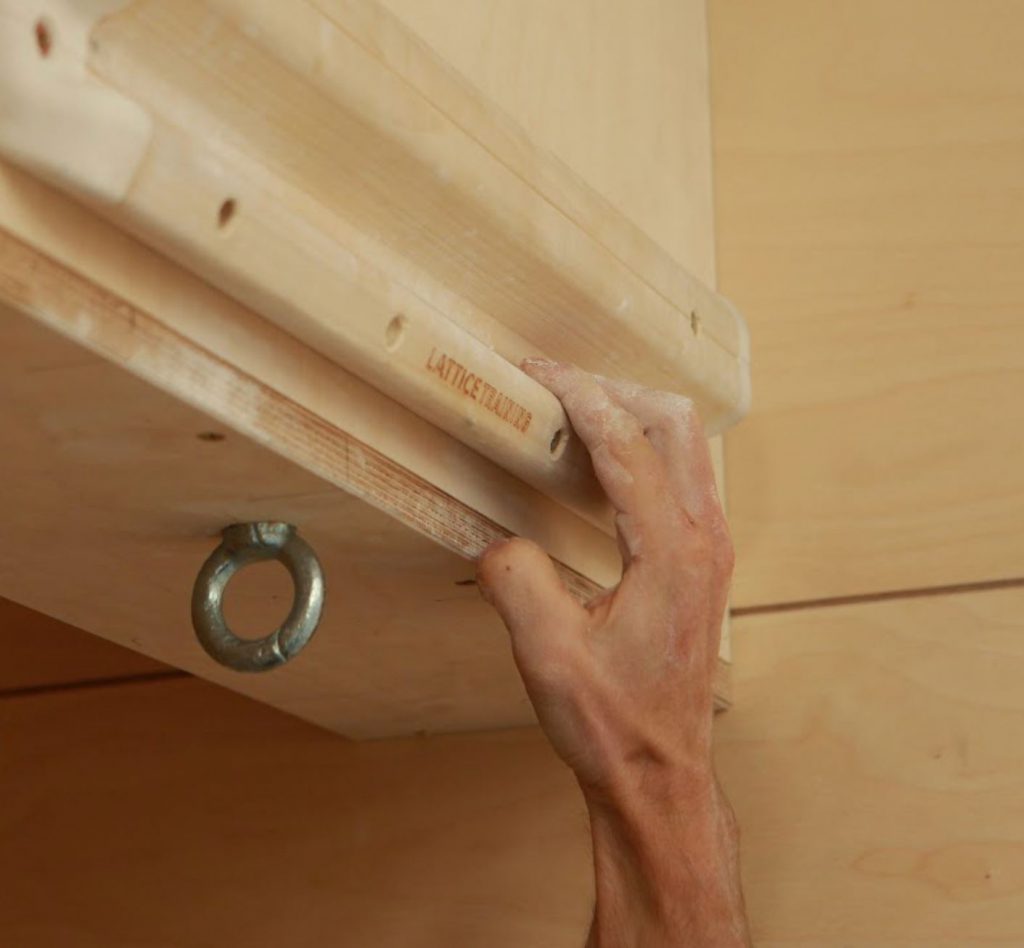
Over Reaching
Training at an intensity that exceeds your body’s ability to recover. Typically over a short period of time e.g. 1-2 weeks. See also Over Training.
Over Training
Consistently over reaching i.e. routinely training at an intensity that exceeds your body’s ability to recover which then leads to long term performance loss. Typically occurs over a period of months. See also Over Reaching.
PAP
Post activation potentiation. Acute excitation of the neuromuscular system following some form of exercise, typically to aid a subsequent performance. For example, a 5RM weighted pull up may be performed prior to a max hang test. There is some evidence that this type of protocol can improve performance in the subsequent test.
[1] https://www.scienceforsport.com/post-activation-potentiation/
PB
Personal best. Your own best effort in a given exercise or measure e.g. “My 2 arm max hang PB is +20kg”.
Peak Period
Climbers spend most of their training year in a base period preparing to peak. As a peak period approaches this base is tapered and fine tuned to allow for those top end performances to be reached. Peak periods typically last 1 – 6 weeks and due to the reduced workload a detraining effect does occur, which is accentuated the longer the peak progresses.
Perfect Repeats
A technique exercise where you focus on repeating boulder problems or routes you have already climbed with precise technical execution.
Periodisation
Progressive cycling of various aspects of a training program during a specific period. E.g. a training plan may focus on building a base for the first 2 months, then switch focus to building power endurance for the next 2 months, then move to a peak period for the next 2 months.
Posterior Chain
A group of muscles at the posterior (back) of the body, referred to as a chain due to the synergistic contraction of these muscles in movements such as hip extension (e.g. deadlift). These muscles include the hamstrings, gluteus maximus, erector spinae, trapezius and more.
Posterior Pelvic Tilt
Rotation of the hips/pelvis backwards. See also Anterior pelvic Tilt.
Power
Exerting a force over time. In particular, accelerating or decelerating during a movement. E.g. “That’s a powerful campus move!”
Powered Out
The feeling you when failing to complete a medium to long (5 to 30) sequence of hard moves. Unlike pump, failure is much more sudden and hard to predict. You can go from feeling fine to powering out in matter of moves. Powering out is more closely associated with failure of the anaerobic system.
Power Endurance
Colloquially, endurance through a sustained sequence of between 5 and 30 difficult moves. See also Energy systems and Anaerobic Glycolysis.
Power Spot
Getting a spotter to take some of your weight while you attempt a move or short sequence so you can focus on remembering the required movement and technique.
Prehab
Pre-emptive rehabilitation. Colloquially this means exercises that will help minimise the risk of future injuries. See also Conditioning.
Prime Mover
The main muscle or muscles involved in a movement e.g. the prime movers of a pull-up are the biceps and latissimus dorsi. See also Stabilisers.
Pumped
The feeling of being pumped is closely associated with route climbing and the aerobic system. Unlike powering out which is much more sudden, pump often creeps up on a climber and in well trained individuals tends to be manageable, or at the very least predictable i.e “If I don’t get to a jug within 10 moves, I’m going to fall off. “
Recovery
The period in between workouts where your body repairs and strengthens itself in response to the training load you have applied to it. Proper recovery is an essential part of effective training.
Rehab
Rehabilitation. The process of recovering from an injury e.g. “I’ve been rehabilitating a bicep strain.”
Relative Energy Deficiency in Sport
RED-S. This is a situation of low energy availability where there is not enough energy remaining for basic bodily functions. This can be a result of undereating and/or overtraining relative to fuelling. It can be intentional (eating disorder or psychological component) or unintentional (accidental mismatch between energy intake and expenditure). There are a range of short and long term health consequences.
Repeaters
A fingerboard exercise involving repeated reps of time hanging on the fingerboard followed by a rest period. E.g. 7 seconds hanging followed by 3 seconds rest, repeated 6 times to complete a full set. Many variations on hang time and rest time exist.
RFD
Rate of Force Development. The rate at which your muscles can start producing force. Typical measures are the force developed 200ms after the start of a contraction and the time to 95% of peak force of the contraction. See also Contact Strength.
Rings
Gymnastic rings, typically used for conditioning exercises and building strength in the shoulder girdle.

RP
Redpoint. A style of climbing where you work the moves and sequences on a route before attempting a clean ascent i.e. with no falls. See also Flash and Onsight.
RPE
Rate of perceived exertion. A 1-10 scale used to describe the perceived intensity of a training session. Typically used where it is impractical or not possible to use an objective measure of intensity (such as a percentage of max).
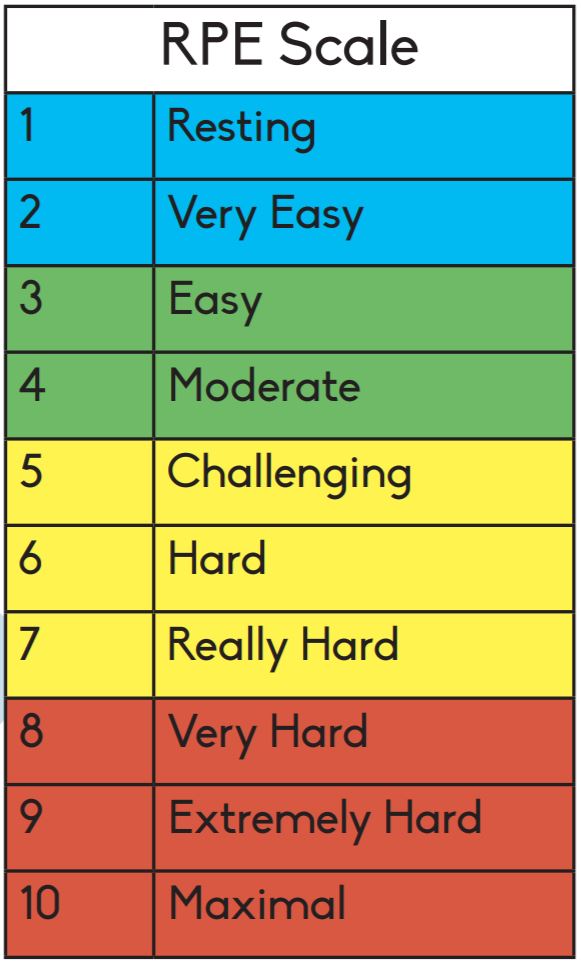
Shoulder Flexion
The motion of bringing an arm overhead.
Shoulder Girdle
The shoulder girdle or pectoral girdle is the set of bones in the shoulders which connects to the arm on each side. In humans it consists of the clavicle and scapula.
Specificity
The concept that an exercise should be specific to the goals to elicit maximum gain from the training stimulus.
Stabilisers
Muscles involved in stabilising a joint during a movement or contraction e.g during a pull-up the triceps, pectorals and rotator cuff muscles act to stabilize the joint as the latissimus dorsi and biceps are the prime movers.
Strength
The maximum force that a muscle group can exert. E.g. “I did a one arm finger strength test and can pull 23kg with my left hand.” See also MVC.
Strength Endurance
See Power Endurance.
Strength to Weight Ratio
Strength to weight ratio (SWR) is defined as the total load lifted / bodyweight. For example, if you could deadhang with +15kg and your bodyweight was 60kg you would say your strength to weight ratio in this exercise is (60 + 15) / 60 = 1.25 or 125%.
Strength to weight ratio is a useful measure as performance in many exercises is strongly correlated with bodyweight. For example, if a 90kg male has a 2RM pull up of +10kg for a total load of 100kg this is significantly less impressive than a 60kg male who has a 2rm pull up of 40kg. They both have a 2rm of 100kg total load, but the former has a SWR of 111%BW while the later has a SWR of 167%BW. Because climbing is a bodyweight sport the climber with the higher SWR will be at a significant advantage.
Systems Board
A woody where the holds are arranged in a systematic fashion. Typically this means the holds are symmetric so that identical climbs may be attempted on the ‘left’ and ‘right’ hand sides.
Taper
See Deload.
Technique
A technique is a climbers way of executing a particular movement. Technique should be effective in allowing continued movement through a sequence of moves. Often there is no right or wrong method as every climbers body is different. That said, some techniques are consistently less efficient than others. Those climbers that choose more efficient techniques tend to need need a lower level of physical training to operate at a given grade. See also Movement Economy and Movement Effectiveness.
Tension
See Trunk Stability.
Tension Board
A woody that also includes a lighting system and app to help record problems. See also Moon Board and Kilter Board.
Training Age
The length of time someone has been training for. See also Climbing Age.
Training Load
The volume x intensity of training over a given time period e.g. “I did 20 laps on a route that’s so hard for me last night, such a huge training load!”
Training Plan
A series of workouts scheduled over a period of time with a particular goal in mind.
Trunk Stability
The trunk includes the chest, back, shoulders and abdomen. The stability of one’s trunk points towards the ability of these muscle groups to work as one. Hence, a lack of trunk stability could suggest over-compensation of one muscle group or a lack of development elsewhere. Good trunk stability facilitates movement economy on the wall.
TRX
A commercialised version of rings that allows for some extra exercise variations.
Volume
The volume of a session or workout refers to the total workload of the session. In climbing this is typically measured by the number of moves. For example, a circuit board session where you climb 500 moves in 2 hours would be a high volume session whereas a limit bouldering session might only mean climbing 10-20 moves over 2 hours and would thus be a low volume (but high intensity) session.
Woody
A woody is a short and steep bouldering wall, typically 30° to 60° overhanging, that is usually used for training strength and power. The name comes from the fact that wooden holds are commonly used because they prevent your skin from wearing excessively while training.
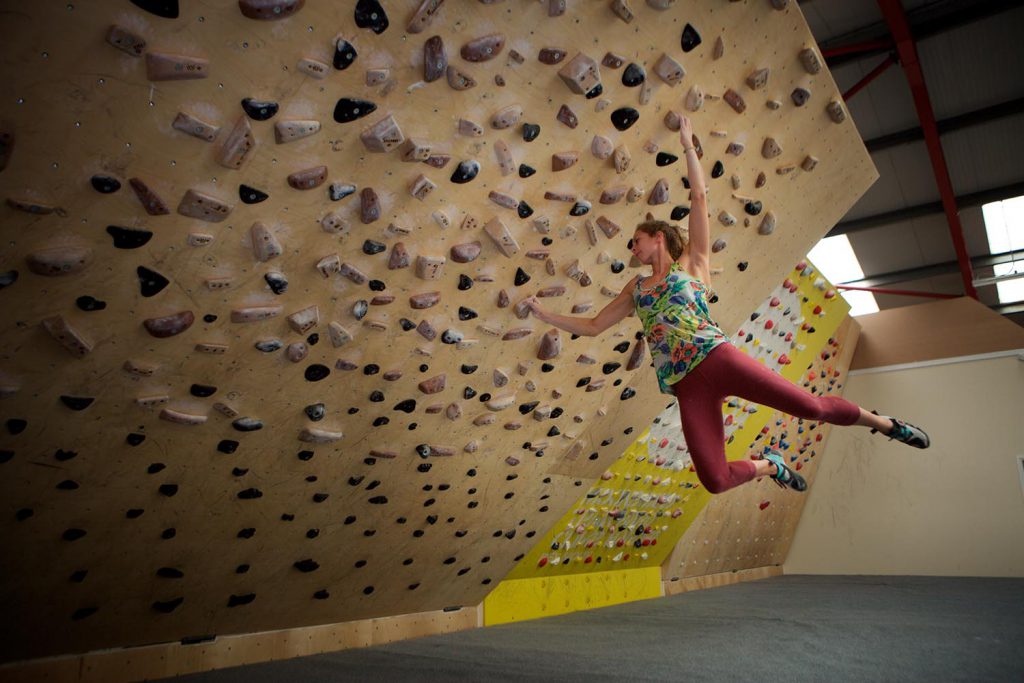
Work Capacity
Your capacity to perform work over a given period of time. Colloquially this is often over the course of a training session or a full day e.g. “You need a good work capacity to climb El Cap”. Also used in the context of a specific exercise e.g. “your work capacity during 50% repeaters is exceptional!”
W’
The work capacity that may be completed above Critical Force is termed as W’ (often described as the “energy store” component). W’ is limited by progressive depletion of high-energy phosphates and accumulation of metabolites associated with peripheral fatigue. See also Critical force curve.
